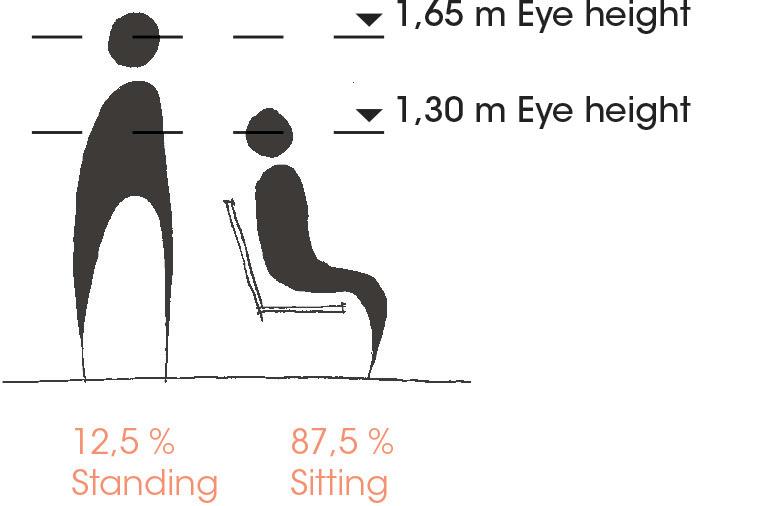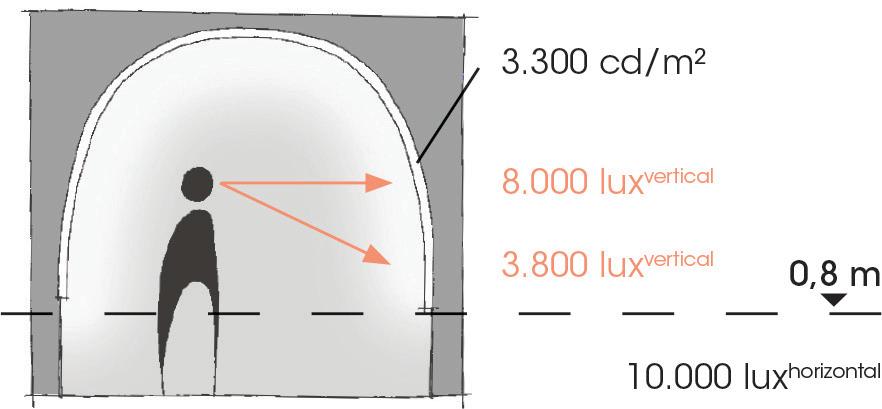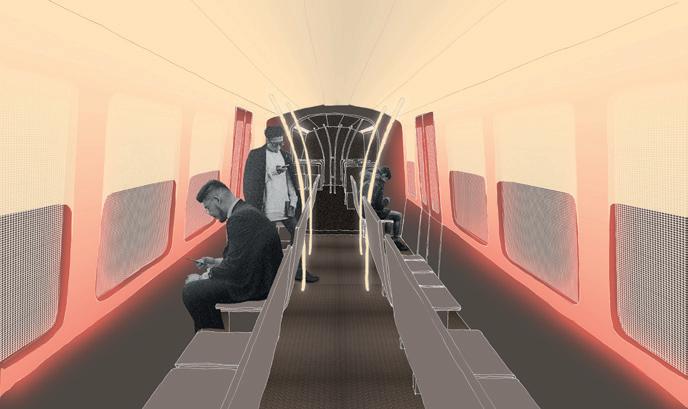
9 minute read
TRAIN OF THOUGHT
Young Lighter 2019 Anna Wawrzyniak outlines her winning proposal for a Light Booster metro car
e are an indoor generation, in many cases spending up to 90 per cent of the day in artificially lit spaces. This results in low levels of exposure to natural light, even though the fact that significant exposure to daylight is crucial to entrain the human’s inner clock, or circadian rhythm, which regulates the sleep-wake cycle and most internal body functions. As we now know, a non-visual receptor (intrinsically photosensitive retinal ganglion cells, or ipRGC) found in the retinas of mammals records the phases of light and darkness, forwarding the information directly to the biological master clock (the suprachiasmatic nuclei, or SCN) rather than to the visual cortex.
Advertisement
Through experiments such as those conducted by the Max Planck Institute for Behavioural Physiology from the 1960s to 1980s, it has been established that without W
exposure to daylight the circadian rhythm drifts from 24 hours to an average 24.18 hours, manifested by eleven minutes’ longer sleep every day. To avoid this steady shift humans need external entrainment to synchronise with the 24-hour rotation of the earth. Employees who have no exposure to daylight in the morning or during the lunch break, and whose workplace may be equipped with a static lighting system as opposed to some form of ‘human-centric lighting’ (HCL), may only have the chance to experience ‘circadian lighting’ in the time they spend commuting.
The mega trend of urbanisation has led to the growth of cities. This expansion has in turn seen an increased duration in the time spent commuting, with an average 20- 60 minutes spent daily on public transport in European cities. By introducing HCL to public transport, particularly in the daylight
Anna Wawrzyniak studied interior architecture at the University of Arts and Design Halle (2012-2017) and graduated with a master’s degree in architectural lighting design 2019 at the Royal Institute of Technology Stockholm. As well as winning the SLL’s Young Lighter 2019, she was awarded the Luxi Lighting Design Prize for Best Lighting Design Concept, newcomer category, for her idea of a Light Booster metro car. She is currently working at the architectural lighting design consultancy Peter Andres Lichtplanung, Hamburg
excluded area of underground metro carriages, this time could be used to provide the commuting workforce with ‘circadian lighting’ while on the way to the workplace.
Dec 21st Hamburg, Germany 18:00 6:00
Mar/Sep 21st Hamburg, Germany 18:00 6:00
Jun 21st Hamburg, Germany 18:00 6:00
Daylight present (Daytime)
Daylight absent (Nighttime)
Commute in public transportation – circadian light can be proposed Artificial office lighting – not sufficient to boost circadian rhythm
6 PROPOSED LIGHT-BOOSTING APPLICATION The proposal is for a Light Booster metro car, which would involve installing special lighting in a single metro carriage, allowing passengers to experience a ‘circadian light boost’ with the aim of supporting their health and wellbeing. The lighting system would need to have the appropriate qualitative characteristics, including the right intensity, spectral distribution, directionality and timing. The proposed lighting concept has been based on a particular underground metro car, type DT5 of Hamburger Hochbahn AG, the local transport company in Hamburg, Germany. This ensured realistic dimensions for the proposed lighting system. As only a single car is refurbished according to this proposal, the likelihood of acceptance, for practical and economic reasons, is increased. To address the potential users’ needs precisely and to create an efficient solution for the comparatively short duration of light exposure, the study involved a literature review, user observation, and lighting measurements of an existing metro car and bright artificial sky dome. The time of light exposure, the duration of exposure, the directionality of the luminaire, the spectral composition and the intensity of light were all considered crucial elements if a positive result is to be achieved.
The average daily commute on public transport (bus, tram, S-Bahn, ferry included) in Hamburg lasts 29 minutes one way. The literature shows that even short exposure of artificial light can contribute to better health and wellbeing, and therefore this length of time would be sufficient for light treatment. It is proposed that the lighting
design should be applied in the morning and afternoon ‘The Light Booster metro car could also offer a colourful artistic light experience at the weekends’
rush hours, between 6am-9am and 4pm7pm, in order to benefit the broadest range of people. The hours in between could be bridged with default lighting. As 87 per cent of passengers were seated during the observation of actual commuters, the conclusion was that the optimal focus for the lighting system was on vertical illuminance at eye height in a sitting position (1.3m).
Dealing with artificial light, energy consumption is also an important factor to consider, and it was important that the design should aim for creative and scientifically proven ways to use resources responsibly. The fact that intermittent light pulses have almost the same effect as continuous light exposure could therefore work to advantage in more than one respect.

Floorplan of car
Measurements made during user observation
Position

The reason might be that ipRGCs are responsible for long-duration pupil size adaptation. The visual system is sensitive to changes rather than continuity in the visual field, and dynamic light levels trigger the ipRGCs more often and raise attention. Monochromatic light at low intensities (8-40 lux) affects the circadian system more effectively than white light. These factors could be integrated into the design both to save energy and make the concept more holistic.
So in summary, implementing HCL in a metro car aims for entrainment of circadian rhythm, a better subjective mood, an increase of sleep quality and a desensitisation to blueish light in the evening. This is achieved while also creating an efficient, aesthetic and sustainable solution. Considering the results of the literature research, the following design principles were developed. The application time of the lighting would be divided into two scenes. For the morning session, the metro car would be illuminated with bright, white light. The white light would have slowly changing intensities to better stimulate the ipRGCells. The literature suggests that a good benchmark light level would be a vertical illuminance above 1000 lux.
Direction of Glance

Measurements taken for metro car and artificial sky dome
Metro Car Lighting

Artificial Sky Dome

Additional areas with vertical illuminance of around 40 lux in tones of blue (470nm) light would supplement the scene. The evening session would feature low levels of white light, illuminance below 100 lux, and red (630nm) light at a level of 40 lux. The introduction of the red light as an energising element, preparing for afterwork activities, is based on research by Figueiro et al: ‘...studies have shown that long-wavelength (red) light exposure increases objective and subjective measures of alertness at night, without suppressing nocturnal melatonin’ (Light at night and measures of alertness and performance:
7 implications for shift workers, 2015).
Both scenes are provided by the same light system, mounted on the ceiling and vertical sides of the metro car to create a high vertical illuminance. Luminance distribution is balanced to allow pupil opening for maximum light input. Between the rush-hour periods, the carriage would be illuminated by default lighting, using only linear parts of the luminous surface. The lighting design shown here is suitable for normal weekdays. However, the Light Booster metro car could offer a colourful artistic light experience at the weekends, addressing a broad range of users and raising awareness of the impact of light.
E
CONCLUSION In conclusion, the Light Booster metro car involves a creative and holistic approach, which aims to take HCL to the next level. The implementation of the proposal can lead to better health and wellbeing. This would arguably increase productivity among employees which can be translated directly into commercial benefit. But an investment in the concept is not only an investment in society, it promotes public transportation, which is beneficial for the environment. The proposed design has an exemplary usage of space based on the number of passengers and frequency. Standard HCL applications in an office environment count one person per 15 square metres, whereas the lighting in a metro carriage supplies four people per square metre. Of course, the costs for energy consumption will be higher than for the lighting of an average metro car. However, in total the yearly energy consumption of one Light Booster metro car roughly equals the yearly consumption of a usual German single household at 2.256 kWh. This result is arguably moderate in relation to the benefits. However, the strongest argument for the concept might be its recognisable and unique nature which could function as a tool to educate people about the crucial exposure to qualitative light. It might start a discussion among city dwellers as to whether urban lifestyles have shifted too far from nature – in particular exposure to daylight – in people’s daily routines, and at what cost. The design raises awareness of the role light plays in ensuring health and wellbeing.
When discussing ‘human-centric lighting’ in general one should proceed with caution, a proviso that has been expressed by a number of researchers and academic bodies: ‘(...), it is not yet possible to predict the nonimage-forming impact of a given illuminant based upon its intensity and spectral composition’ (Measuring and using light in the melanopsin age, Lucas et al, 2014). Lighting design proposals must consider the context of a space, its users and their activities. More research and applied research findings in practice is needed to prove the theoretical results. Implementing the idea of a Light Booster metro car in practice, under scientific control (for example, a postoccupant evaluation) could develop new insights in the field of ‘circadian lighting’.
It has to be acknowledged that the concept
Visualisation of default lighting

Visualisation of morning lighting

Design principles for morning setting
Design principles for afternoon setting
consumes resources which might not be necessary if people’s behaviour changed – 30 minutes of daylight in the first part of the day, whether the bike ride to work or a walk in the lunch break, would be equally if not more beneficial for health and wellbeing.
HCL concepts try to mimic the advantages of daylight. They are still predicated on artificial lighting, a symptom of an indoor generation, which lacks light, air and movement in nature. They are indicative of
8

Visualisation of evening lighting

Visualisation of weekend lighting


an economy-centric, rather than humancentric, urban environment. While they are at least better than average artificial light, they do not address the root of the problem. Perhaps we should rethink how to build communities to enable an even larger fraction of the population to enjoy the benefits of micro commutes, making walking or cycling to work more feasible. Ultimately, greater exposure to natural light remains the best solution.







